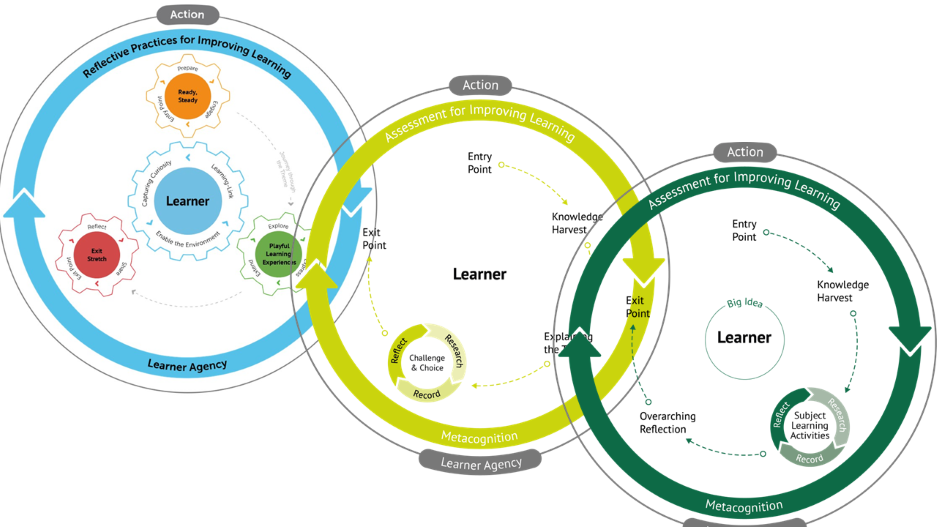Personal, Subject and International Learning can all influence the well-being of individuals and whole learning communities. The 8 Personal Learning Goals, common across all the International Curriculum Association (ICA) curricula, are both explicitly and implicitly taught and contribute to learners' wellbeing. Rather than a ‘hidden curriculum’ of values and culture that can exclude children who may miss the subtle cues, a transparent, unhidden curriculum is inclusive and invites all learners to master life lessons for their own and others' wellbeing. A shared vision for learners that references success in all aspects of life promotes well-being and makes it an inclusive responsibility for all stakeholders.
Research tells us that wellbeing impacts our ability to learn and that stress directly inhibits learning. Educational research shows that the best state for learning is ‘relaxed alertness’. In this state, a child is calm, focused and attentive while engaging in a learning activity or task. Wellbeing is essential for successful learning.
Each program in the ICA reduces stress through
- A predictable learning path called the Process to Facilitate Learning
- Signposting Learning Goals for each session
- Self-selected challenge
Wellbeing in the written curriculum is represented in SEL, PSHE or learning for life classes and is known to positively impact learners and learning.
"The evidence shows that PSHE education can improve the physical and psychosocial wellbeing of pupils. A virtuous cycle can be achieved, whereby pupils with better health and wellbeing achieve better academically."
Department for Education (England), Personal, social, health and economic (PSHE) education: a review of impact and effective practice, 2015.
In the International Early Years Curriculum (IEYC), wellbeing is a constant focus as we support our youngest learners to start to identify and understand their emotional world and the emotional world of others. The children are encouraged to label their emotions to enable them to communicate, articulate and problem solve their experiences.
Through our International dimension in the IEYC, we encourage our early years children to have agency over their worlds. We build in opportunities for them to take and assess risks, celebrate their independence in activities and follow their own interests. All of these contribute to an increased awareness of their own self and therefore their own well-being.
Crucially our early years curriculum is holistic at heart, encouraging both children and adults to act with their whole being and to follow their curiosity. We start all learning with the children’s interests and endeavour to follow their lead. This feeling of control for each child is a vital and powerful ingredient in the well-being picture.
Health and wellbeing are explicitly included across all mileposts in the International Primary Curriculum (IPC). Each year children engage with a Brainwave unit which focuses on learning about how the brain works and how we can care for this amazing organ. They also explore the connection between emotions and learning, this awareness helps learners to take responsibility for aspects of their own wellbeing and develop self-regulation techniques.
Social and emotional development and wellbeing are explored through units focused on building and maintaining friendships for young learners and positive relationships for older primary learners heading towards puberty.
Learning to manage change is a significant contributor to wellbeing. The transition from primary to secondary can be a challenging period in a young person’s school life. Viewing transition as an extended, supported process helps students begin secondary school with a positive, confident outlook which has long-term benefits for learning, social and emotional health, and wellbeing.
In the International Middle Years Curriculum (IMYC), wellbeing is further enriched by integrating the research by the IMPART model into the learning process. Specifically catering to the unique needs of adolescents, the IMPART model stands for Interlinking learning, Making Meaning, Peers, Agency, Risk-taking, and Transition, which addresses the six key needs of the teenage brain. Understanding the needs of the teenage brain ensures an alignment of teenagers’ cognitive and emotional development. It helps to shape a holistic educational experience that enhances not just academic learning but also contributes to the overall health and well-being of students, shaping them into resilient, responsible, and successful adults. The IMYC approach ensures that learning is meaningful and interconnected, encouraging students to engage actively with their peers, take calculated risks, and manage transitions smoothly.
Additionally, the IMYC continues the focus on wellbeing with Brainwave units which delve deeper into understanding the brain's functions and its impact on the learner in the middle years. Students explore mindfulness, positive psychology, metacognitive strategies, and study skills, all of which are crucial for their academic and personal development. By incorporating these units, the IMYC empowers students to take charge of their learning process and wellbeing, fostering a growth mindset and preparing them for the challenges of adolescence and beyond. Through these comprehensive efforts, the IMYC aims to nurture the complexities of being a teenager during the middle years and encourages learners to be well-equipped to thrive in their personal, social and academic lives.
A whole school approach to wellbeing through curriculum, policies, personal development initiatives, and community culture can benefit all learners. Explicit teaching and learning about wellbeing accompanied by a supportive culture are expectations of the holistic education offered by all ICA schools.
“Taking a whole school approach to health and well-being is linked to pupils’ readiness to learn. A recent review of the link between pupil health and wellbeing and attainment advocated promotion of health and well-being as an essential element of a school’s effectiveness strategy.”
Department for Education (England), Personal, social, health and economic (PSHE) education: a review of impact and effective practice, 2015
Pause for thought: Does your school culture as defined by its vision and mission acknowledge the importance of and promote wellbeing? Do your school systems and policies explicitly support wellbeing? Is the wellbeing of all stakeholders in the learning community fostered and monitored?


